Microstructure and Mechanical Properties of As-Built Ti-6Al-4V and Ti-6Al-7Nb Alloys Produced by Selective Laser Melting Technology
Abstract
1. Introduction
2. Materials and Methods
2.1. Powders’ Characterization
2.2. Samples Fabrication
2.3. Relative Density
2.4. Surface Morphology
2.5. Surface Topography and Roughness
2.6. Microstructure and Structural Defects
2.7. Microhardness Tests
2.8. Uniaxial Tensile Tests
3. Results and Discussion
3.1. Relative Density and Structural Defects
3.2. Surface
3.3. Microhardness
3.4. Microstructure
3.5. Tensile Test Results
4. Conclusions
Author Contributions
Funding
Institutional Review Board Statement
Informed Consent Statement
Data Availability Statement
Conflicts of Interest
References
- Yuan, L.; Ding, S.; Wen, C. Additive manufacturing technology for porous metal implant applications and triple minimal surface structures: A review. Bioact. Mater. 2019, 4, 56–70. [Google Scholar] [CrossRef] [PubMed]
- Li, Y.; Yang, C.; Zhao, H.; Qu, S.; Li, X.; Li, Y. New Developments of Ti-Based Alloys for Biomedical Applications. Materials 2014, 7, 1709–1800. [Google Scholar] [CrossRef] [PubMed]
- Niinomi, M. Mechanical biocompatibilities of titanium alloys for biomedical applications. J. Mech. Behav. Biomed. Mater. 2008, 1, 30–42. [Google Scholar] [CrossRef]
- Eliasm, C.N.; Lims, J.H.C.; Valiev, R.; Meyers, M.A. Biomedical applications of titanium and its alloys. JOM 2008, 60, 46–49. [Google Scholar] [CrossRef]
- Rack, H.J.; Qazi, J.I. Titanium alloys for biomedical applications. Mater. Sci. Eng. C 2006, 26, 1269–1277. [Google Scholar] [CrossRef]
- ASTM ISO/ASTM52900-15; Standard Terminology for Additive Manufacturing-General Principles-Part 1: Terminology. ISO: Geneva, Switzerland, 2002.
- Bose, S.; Ke, D.; Sahasrabudhe, H.; Bandyopadhyay, A. Additive manufacturing of biomaterials. Prog. Mater. Sci. 2018, 93, 45–111. [Google Scholar] [CrossRef]
- Murry, L.E. Strategies for creating living, additively manufactured, open-cellular metal and alloy implants by promoting osseointegration, osteoinduction and vascularization: An overview. J. Mater. Sci. Technol. 2019, 35, 231–241. [Google Scholar] [CrossRef]
- Chen, H.; Liu, Y.; Wang, C.; Zhang, A.; Chen, B.; Han, Q.; Wang, J. Design and properties of biomimetic irregular scaffolds for bone tissue engineering. Comput. Biol. Med. 2021, 130, 104241. [Google Scholar] [CrossRef]
- Kanwar, S.; Vijayavenkataraman, S. Design of 3D printed scaffolds for bone tissue engineering: A review. Bioprinting 2021, 24, e00167. [Google Scholar] [CrossRef]
- Maconachie, T.; Leary, M.; Lozanovski, B.; Zhang, X.; Qian, M.; Faruque, O.; Brandt, M. SLM lattice structures: Properties, performance, applications and challenges. Mater. Des. 2019, 183, 108137. [Google Scholar] [CrossRef]
- Riva, L.; Ginestra, P.S.; Ceretti, E. Mechanical characterization and properties of laser-based powder bed-fused lattice structures: A review. Int. J. Adv. Manuf. Technol. 2021, 113, 649–671. [Google Scholar] [CrossRef]
- Dong, Z.; Zhao, X. Application of TPMS structure in bone regeneration. Eng. Regener. 2021, 2, 154–162. [Google Scholar] [CrossRef]
- Laskowska, D.; Szatkiewicz, T.; Bałasz, B.; Mitura, K. Mechanical Properties and Energy Absorption Abilities of Diamond TPMS Cylindrical Structures Fabricated by Selective Laser Melting with 316L Stainless Steel. Materials 2023, 16, 3196. [Google Scholar] [CrossRef] [PubMed]
- Zhang, X.Y.; Fang, G.; Zhou, J. Additively Manufactured Scaffolds for Bone Tissue Engineering and the Prediction of their Mechanical Behavior: A Review. Materials 2017, 10, 50. [Google Scholar] [CrossRef]
- Cooke, S.; Ahmadi, K.; Willerth, S.; Herring, R. Metal additive manufacturing: Technology, metallurgy and modelling. J. Manuf. Process. 2020, 57, 978–1003. [Google Scholar] [CrossRef]
- Zheng, Z.; Jin, X.; Bai, Y.; Yang, Y.; Ni, C.; Lu, W.F.; Wang, H. Microstructure and anisotropic mechanical properties of selective laser melted Ti6Al4V alloy under different scanning strategies. Mater. Sci. Eng. A 2022, 831, 142236. [Google Scholar] [CrossRef]
- Hitzler, L.; Hirsch, J.; Heine, B.; Merkel, M.; Hall, W.; Öchsner, A. On the Anisotropic Mechanical Properties of Selective Laser-Melted Stainless Steel. Materials 2017, 10, 1136. [Google Scholar] [CrossRef]
- DebRoy, T.; Wei, H.L.; Zuback, J.S.; Mukherjee, T.; Elmer, J.W.; Milewski, J.O.; Beese, A.M.; Wilson-Heid, A.; De, A.; Zhang, W. Additive manufacturing of metallic components—Process, structure and properties. Prog. Mater. Sci. 2018, 92, 112–224. [Google Scholar] [CrossRef]
- Laskowska, D.; Mitura, K.; Ziółkowska, E.; Bałasz, B. Additive manufacturing methods, materials and medical applications—The review. J. Mech. Energy Eng. 2021, 5, 15–30. [Google Scholar] [CrossRef]
- Ngo, T.D.; Kashani, A.; Imbalzano, G.; Nguyen, K.T.Q.; Hui, D. Additive manufacturing (3D printing): A review of materials, methods, applications and challenges. Compos. Part. B 2018, 143, 172–196. [Google Scholar] [CrossRef]
- Hebert, R.J. Viewpoint: Metallurgical aspects of powder bed metal additive manufacturing. J. Mater. Sci. 2016, 53, 1165–1175. [Google Scholar] [CrossRef]
- King, W.E.; Barth, H.D.; Castillo, V.M.; Gallegos, G.F.; Gibbs, J.W.; Hahn, D.E.; Kamath, C.; Rubenchik, A.M. Observation of keyhole-mode laser melting in laser powder-bed fusion additive manufacturing. J. Mater. Process. Technol. 2014, 214, 2915–2925. [Google Scholar] [CrossRef]
- Dev Singh, D.; Mahender, T.; Raji Reddy, A. Powder bed fusion process: A brief review. Mater. Today Proc. 2021, 46, 350–355. [Google Scholar] [CrossRef]
- Rombouts, M.; Kruth, J.P.; Froyen, L.; Mercelis, P. Fundamentals of Selective Laser Melting of alloyed steel powders. CIRP Ann. 2006, 55, 187–192. [Google Scholar] [CrossRef]
- Kruth, J.P.; Levy, G.; Klocke, F.; Childs, T.H.C. Consolidation phenomena in laser and powder-bed based layered manufacturing. CIRP Ann. 2007, 56, 730–806. [Google Scholar] [CrossRef]
- Liu, Y.; Yang, Y.; Mai, S.; Wang, D.; Song, C. Investigation into spatter behavior during selective laser melting of AISI 316L stainless steel powder. Mater. Des. 2015, 87, 797–806. [Google Scholar] [CrossRef]
- Neikter, M.; Huang, A.; Wu, X. Microstructural characterization of binary microstructure pattern in selective laser-melted Ti-6Al-4V. Int. J. Adv. Manuf. Technol. 2019, 104, 1381–1391. [Google Scholar] [CrossRef]
- Widomski, C.; Solas, D.; Baudin, T.; Brisset, F.; Lebel, S.; Helbert, A.L. Heterogeneity of microstructure, texture and mechanical properties along the building direction of Ti-6Al-4V alloy developed by SLM. IOP Conf. Ser. Mater. Sci. Eng. 2021, 1121, 012031. [Google Scholar] [CrossRef]
- Eskandari, H.; Lashgari, H.R.; Zangeneh, S.; Kong, C.; Ye, L.; Eizadjou, M.; Wang, H. Microstructural characterization and mechanical properties of SLM-printed Ti–6Al–4V alloy: Effect of build orientation. J. Mater. Res. 2022, 37, 2645–2660. [Google Scholar] [CrossRef]
- Dareh Baghi, A.; Nafisi, S.; Ebendorff-Heidepriem, H.; Ghomashchi, R. Microstructural Development of Ti-6Al-4V Alloy via Powder Metallurgy and Laser Powder Bed Fusion. Metals 2022, 12, 1462. [Google Scholar] [CrossRef]
- Chlebus, E.; Kuźnicka, B.; Kurzynowski, T.; Dybała, B. Microstructure and mechanical behaviour of Ti―6Al―7Nb alloy produced by selective laser melting. Mater. Charact. 2011, 62, 488–495. [Google Scholar] [CrossRef]
- Xu, C.; Sikan, F.; Atabay, S.E.; Muñiz-Lerma, J.A.; Sanchez-Mata, O.; Wang, X.; Brochu, M. Microstructure and mechanical behavior of as-built and heat-treated Ti–6Al–7Nb produced by laser powder bed fusion. Mater. Sci. Eng. A 2020, 793, 139978. [Google Scholar] [CrossRef]
- PN-ISO 9276-1:1998; Representation of results of particle size analysis—Part 1: Graphical representation. ISO: Geneva, Switzerland, 1998.
- Dursun, G.; Ibekwe, S.; Li, G.; Mensah, P.; Joshi, G.; Jerro, D. Influence of laser processing parameters on the surface characteristics of 316L stainless steel manufactured by selective laser melting. Mater. Today Proc. 2020, 26, 387–393. [Google Scholar] [CrossRef]
- Zhao, R.; Chen, C.; Wang, W.; Cao, T.; Shuai, S.; Xu, S.; Hu, T.; Liao, H.; Wang, J.; Ren, Z. On the role of volumetric energy density in the microstructure and mechanical properties of laser powder bed fusion Ti-6Al-4V alloy. Addit. Manuf. 2022, 51, 102605. [Google Scholar] [CrossRef]
- PN-EN ISO 6892-1:2020-05; Metals, Tensile Test, Part 1: Room Temperature Test Method. ISO: Geneva, Switzerland, 2020.
- ISO 25178-2:2021; Geometrical Product Specifications (GPS), Surface Texture: Areal, Part 2: Terms, Definitions and Surface Texture Parameters. ISO: Geneva, Switzerland, 2021.
- Townsend, A.; Senin, N.; Blunt, L.; Leach, R.K.; Taylor, J.S. Surface texture metrology for metal additive manufacturing: A review. Precis. Eng. 2016, 46, 34–47. [Google Scholar] [CrossRef]
- Triantaphyllou, A.; Giusca, C.L.; Macaulay, G.D.; Roerig, F.; Hoebel, M.; Leach, R.K.; Tomita, B.; Milne, A.K. Surface texture measurement for additive manufacturing. Surf. Topogr. Metrol. Prop. 2015, 3, 024002. [Google Scholar] [CrossRef]
- Metallographic Preparation of Titanium, Stuers. 2024. Available online: https://publications.struers.com/brochures/english/application-notes/titanium/?_ga=2.65597550.1793077269.1699704274-2146115658.1699704274 (accessed on 15 January 2024).
- Bustillos, J.; Kim, J.; Moridi, A. Exploiting lack of fusion defects for microstructural engineering in additive manufacturing. Addit. Manuf. 2021, 48, 102399. [Google Scholar] [CrossRef]
- Liverani, E.; Toschi, S.; Ceschini, L.; Fortunato, A. Effect of selective laser melting (SLM) process parameters on microstructure and mechanical properties of 316L austenitic stainless steel. J. Mater. Process. Technol. 2017, 249, 255–263. [Google Scholar] [CrossRef]
- Aboulkhair, N.T.; Everitt, N.M.; Ashcroft, I.; Tuck, C. Reducing porosity in AlSi10Mg parts processed by selective laser melting. Addit. Manuf. 2014, 1–4, 77–86. [Google Scholar] [CrossRef]
- Cabanettes, F.; Joubert, A.; Chardon, G.; Dumas, V.; Rech, J.; Grosjean, C.; Dimkovski, Z. Topography of as built surfaces generated in metal additive manufacturing: A multi scale analysis from form to roughness. Precis. Eng. 2018, 52, 249–265. [Google Scholar] [CrossRef]
- Thompson, A.; Senin, N.; Leach, R.K. Towards an additive surface atlas. In Proceedings of the ASPE/Euspen Conference on Dimensional Accuracy and Surface Finish from Additive Manufacturing, Raleigh, NC, USA, 27–30 June 2016; pp. 27–30. [Google Scholar]
- Motyka, M.; Kubiak, K.; Sieniawski, J.; Ziaja, W. Phase Transformations and Characterization of α + β Titanium Alloys. In Comprehensive Materials Processing; Elsevier: Amsterdam, The Netherlands, 2014; pp. 7–36. [Google Scholar]
- Thijs, L.; Verhaeghe, F.; Craeghs, T.; Van Humbeeck, J.; Kruth, J.-P. A study of the microstructural evolution during selective laser melting of Ti–6Al–4V. Acta Mater. 2010, 58, 3303–3312. [Google Scholar] [CrossRef]
- Simonelli, M.; Tse, Y.Y.; Tuck, C. Microstructure of Ti-6Al-4V produced by selective laser melting. J. Phys. Conf. Ser. 2012, 371, 012084. [Google Scholar] [CrossRef]
- Simonelli, M.; Tse, Y.Y.; Tuck, C. The formation of α + β microstructure in as-fabricated selective laser melting of Ti–6Al–4V. J. Mater. Res. 2014, 29, 2028–2035. [Google Scholar] [CrossRef]
- Yan, Q.; Chen, B.; Kang, N.; Lin, X.; Lv, S.; Kondoh, K.; Li, S.; Li, J.S. Comparison study on microstructure and mechanical properties of Ti-6Al-4V alloys fabricated by powder-based selective-laser-melting and sintering methods. Mater. Charact. 2020, 164, 110358. [Google Scholar] [CrossRef]
- Vilaro, T.; Colin, C.; Bartout, J.D. As-Fabricated and Heat-Treated Microstructures of the Ti-6Al-4V Alloy Processed by Selective Laser Melting. Met. Mater. Trans. A 2011, 42, 3190–3199. [Google Scholar] [CrossRef]
- Yvinec, T.; Nait-Ali, A.; Mellier, D.; Bertheau, D.; Cormier, J.; Villechaise, P.; Rat, L.; Hemery, S. Tensile properties of Ti-6Al-4V as-built by laser metal deposition: The relationship between heat affected zone bands, strain localization and anisotropy in ductility. Addit. Manuf. 2022, 55, 102830. [Google Scholar] [CrossRef]
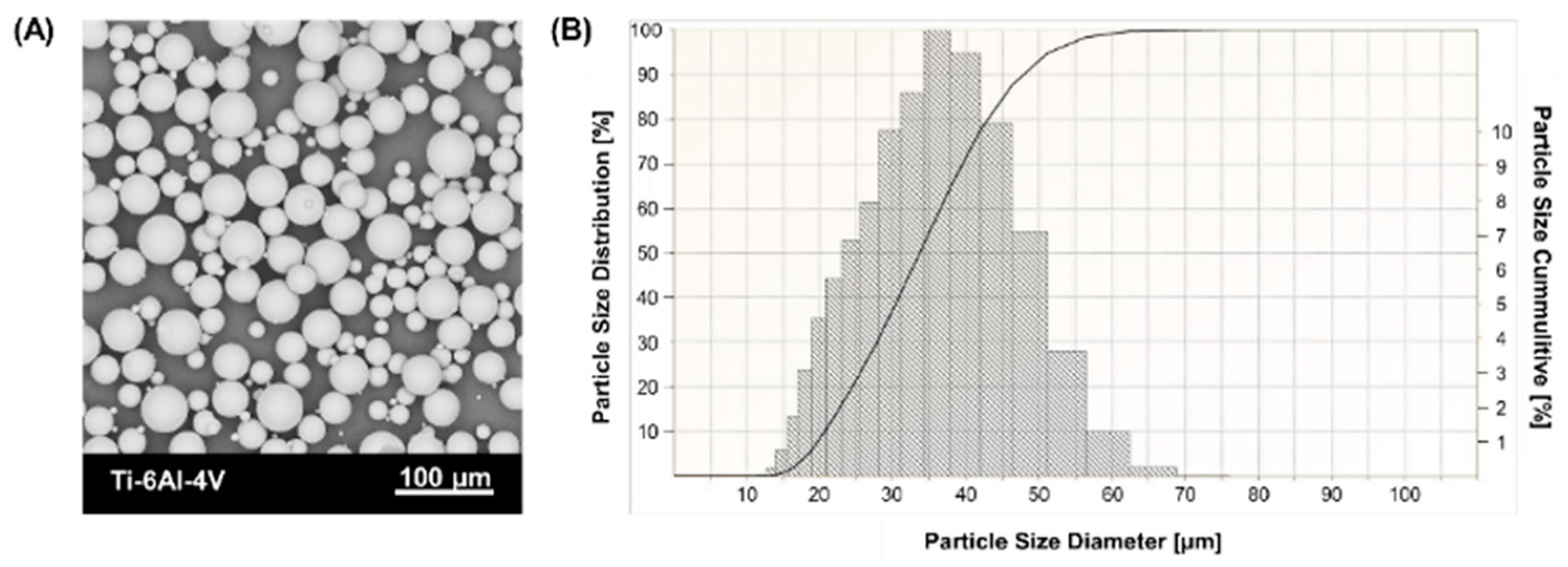

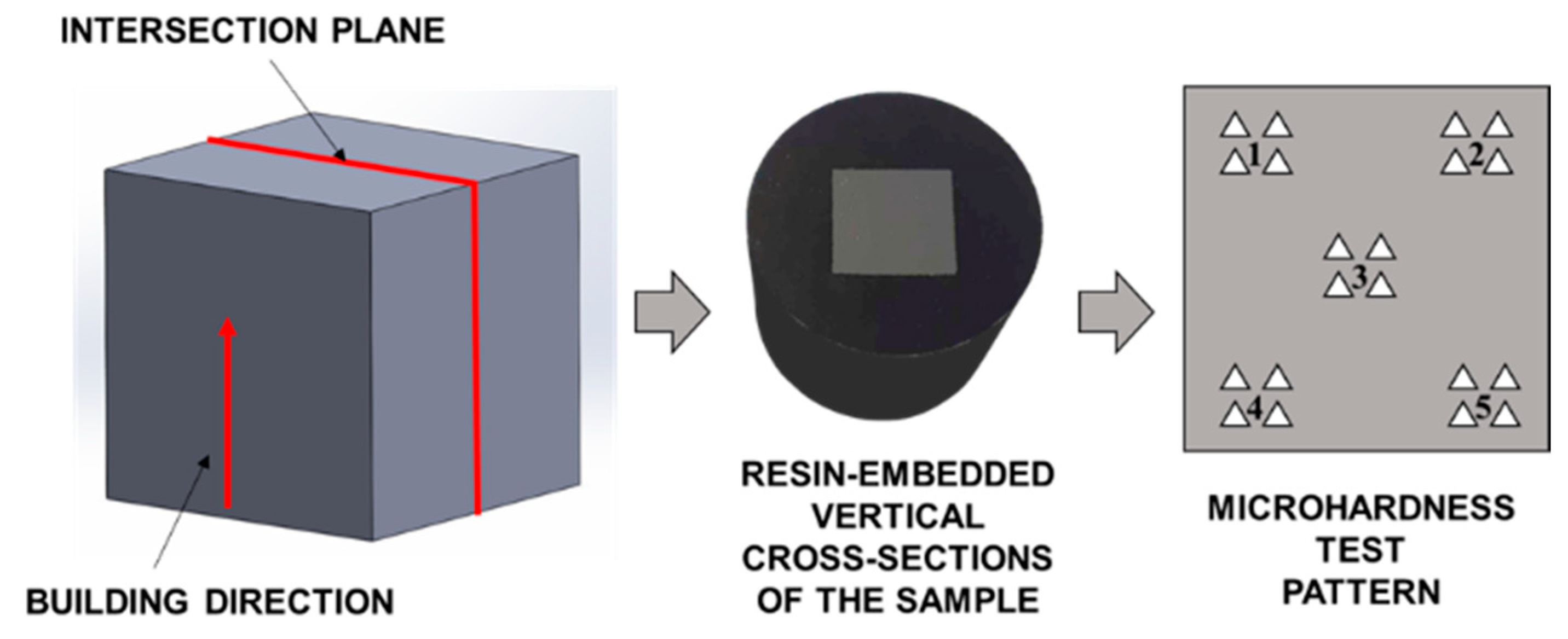
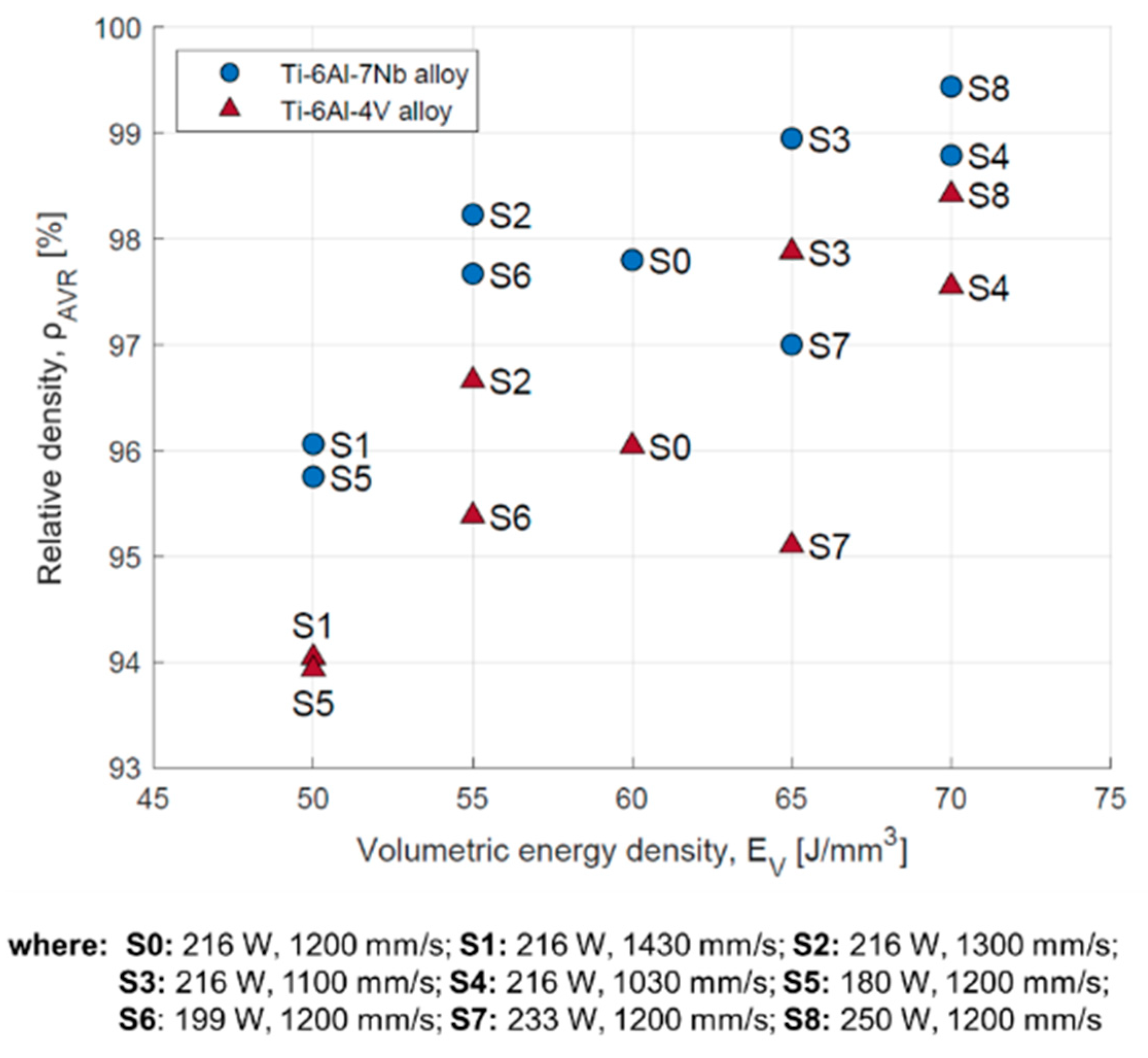
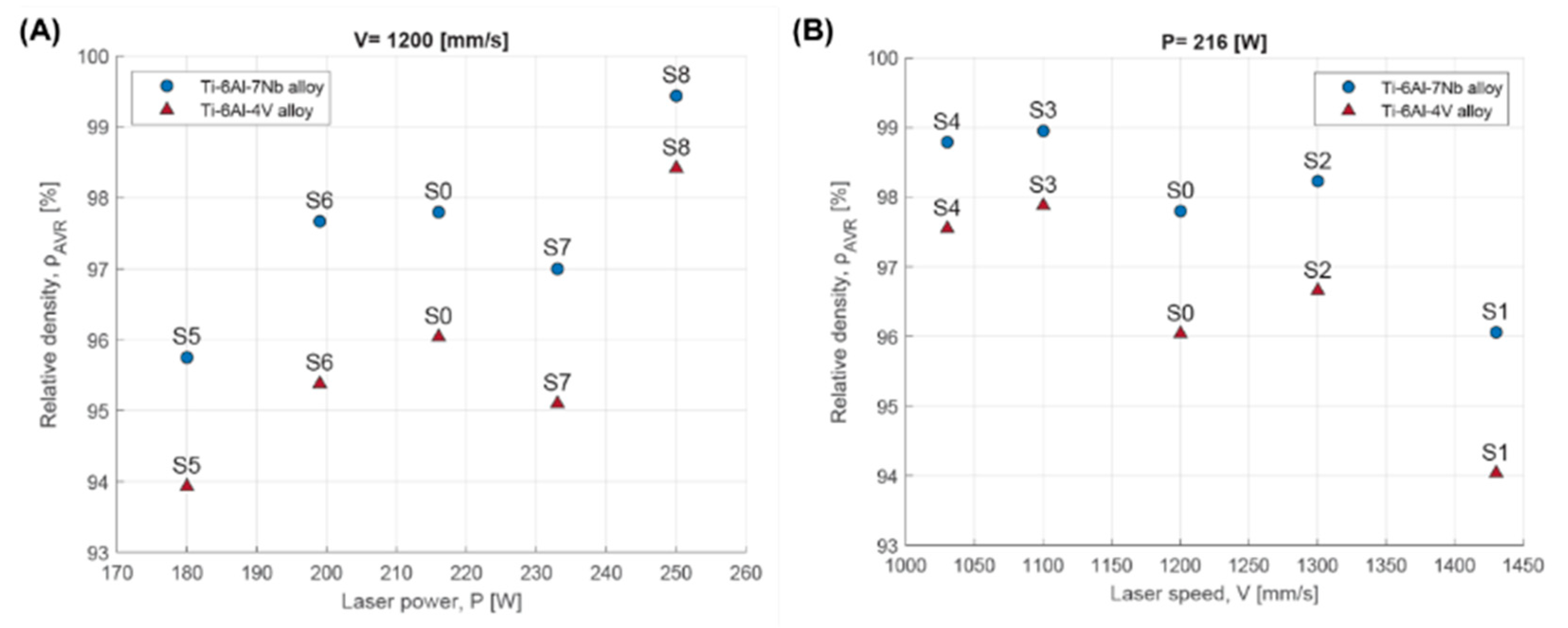
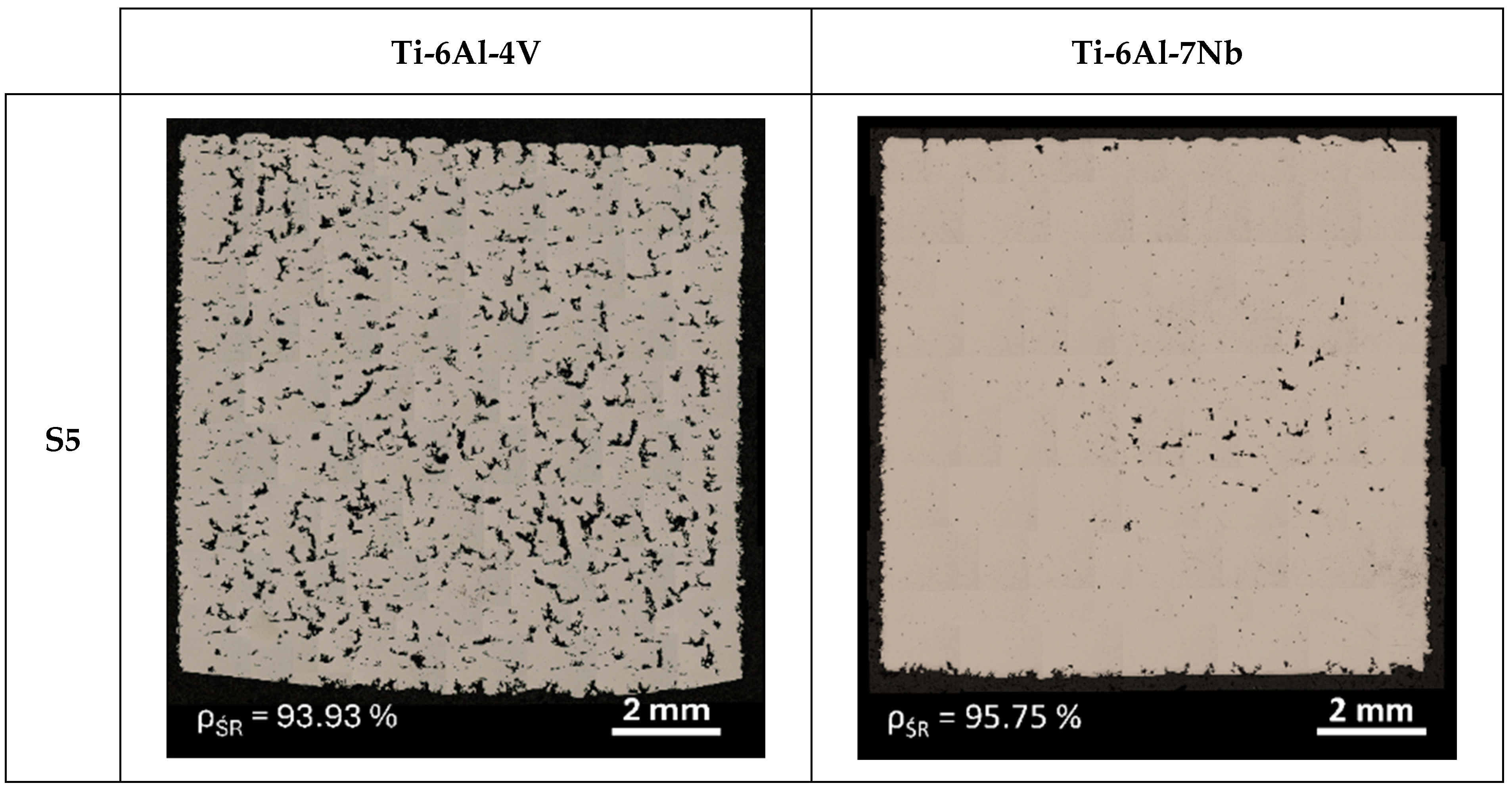
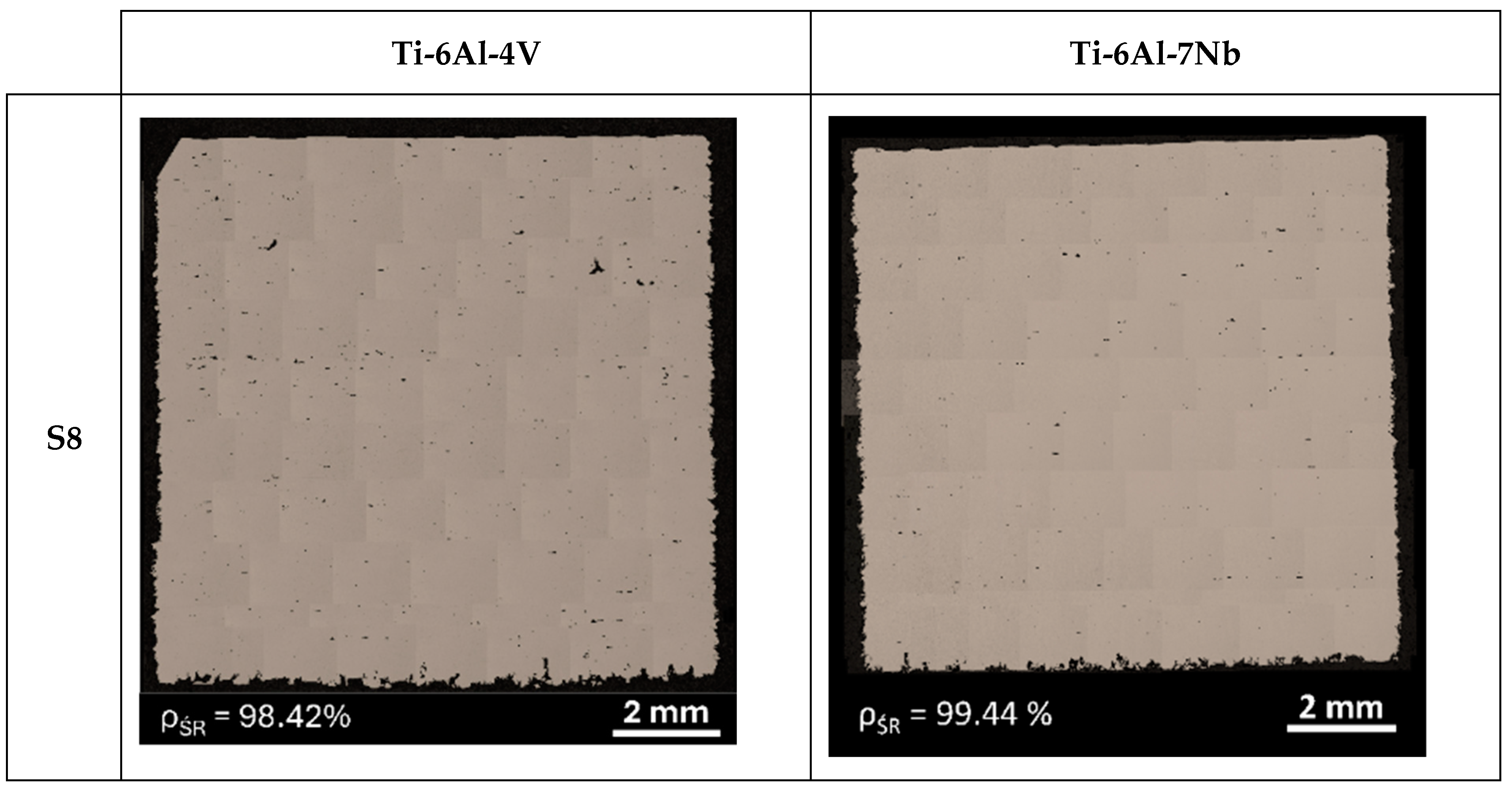
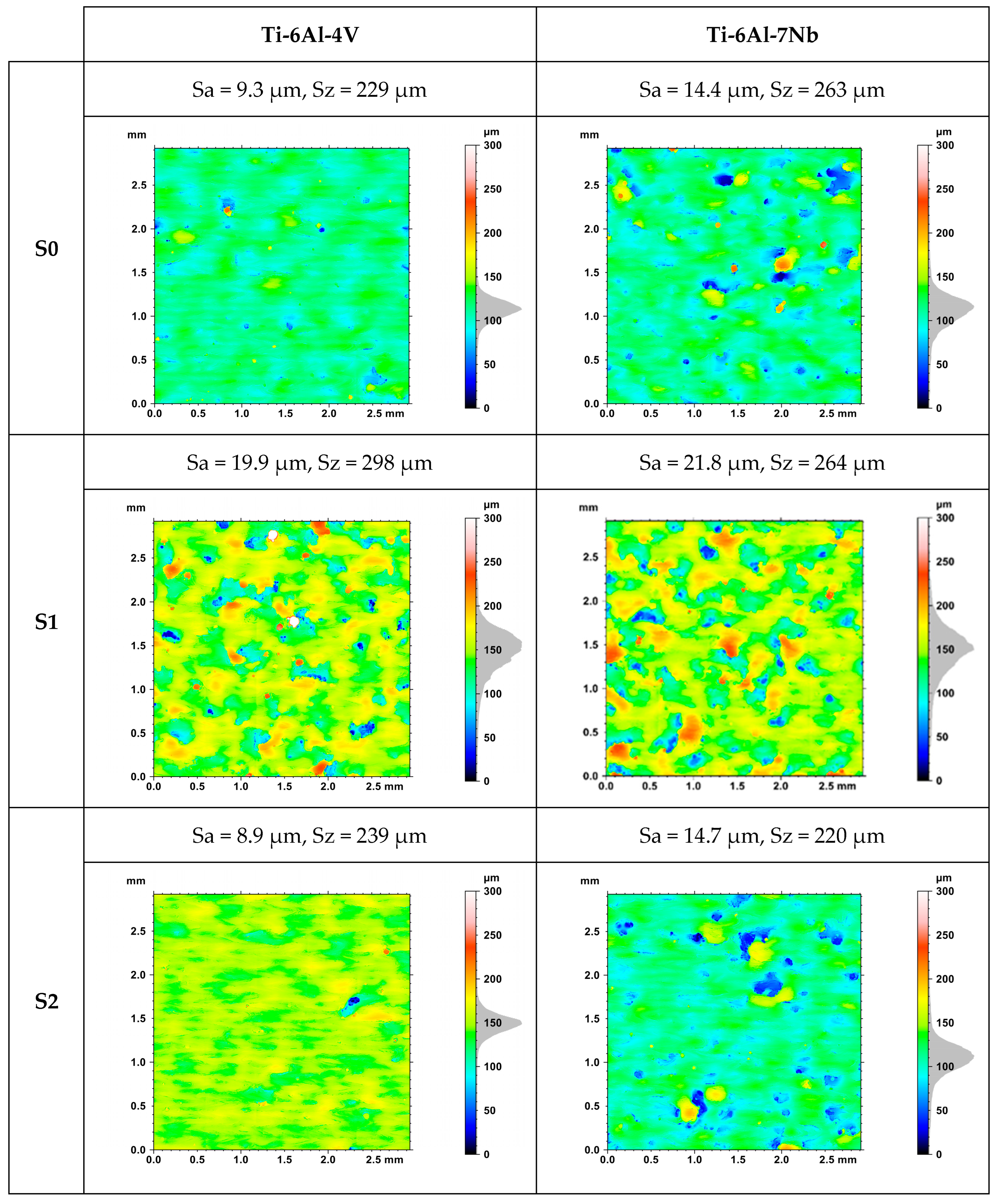
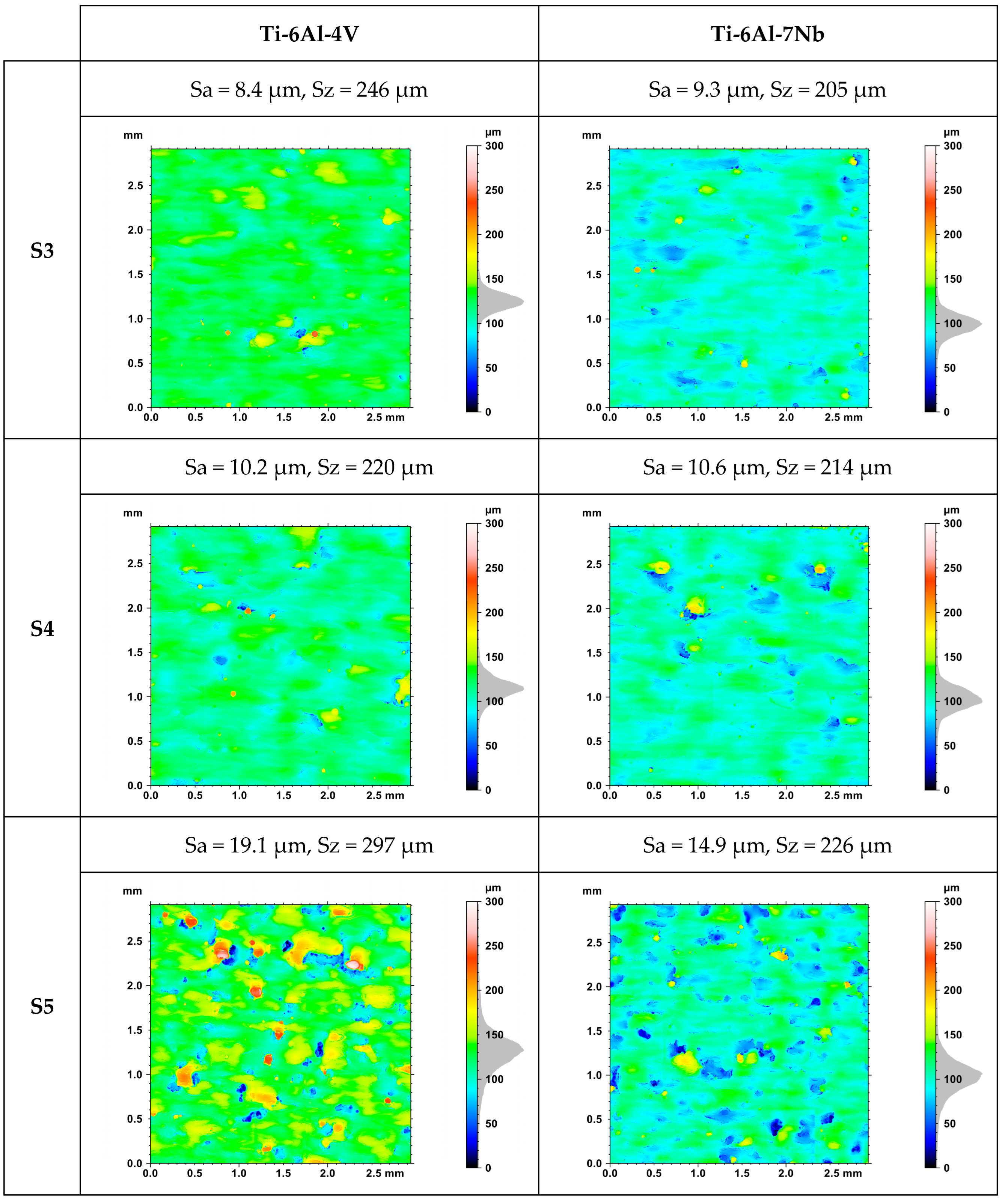

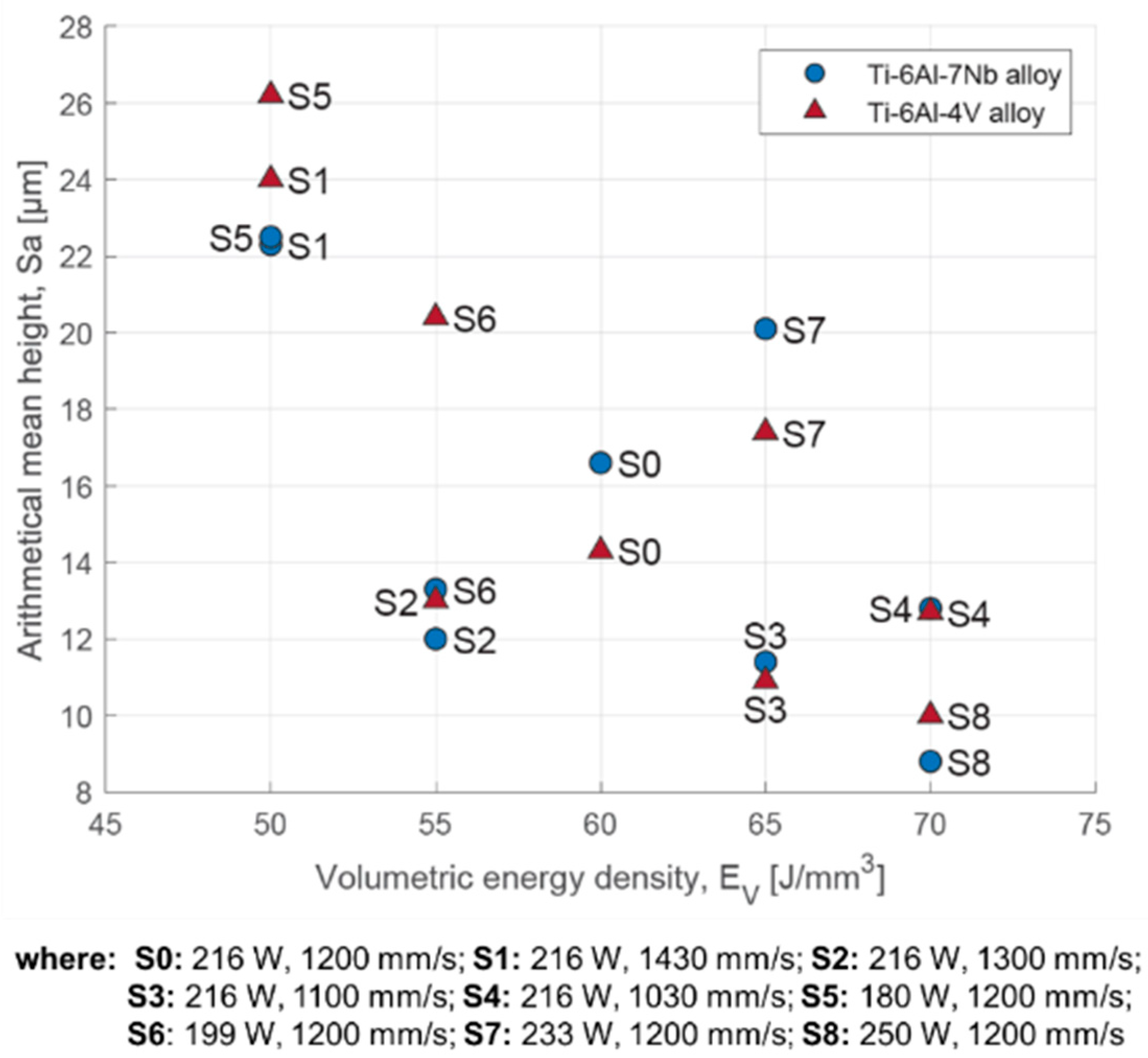
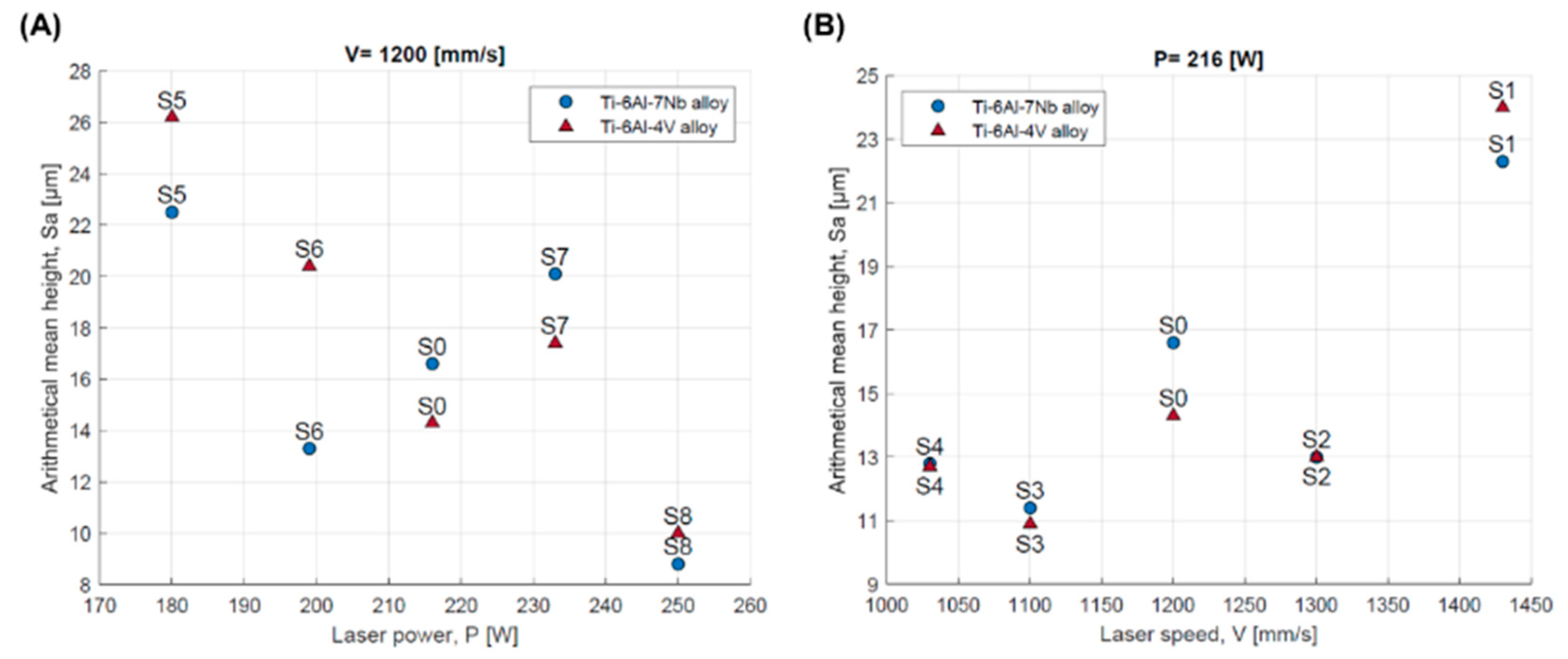


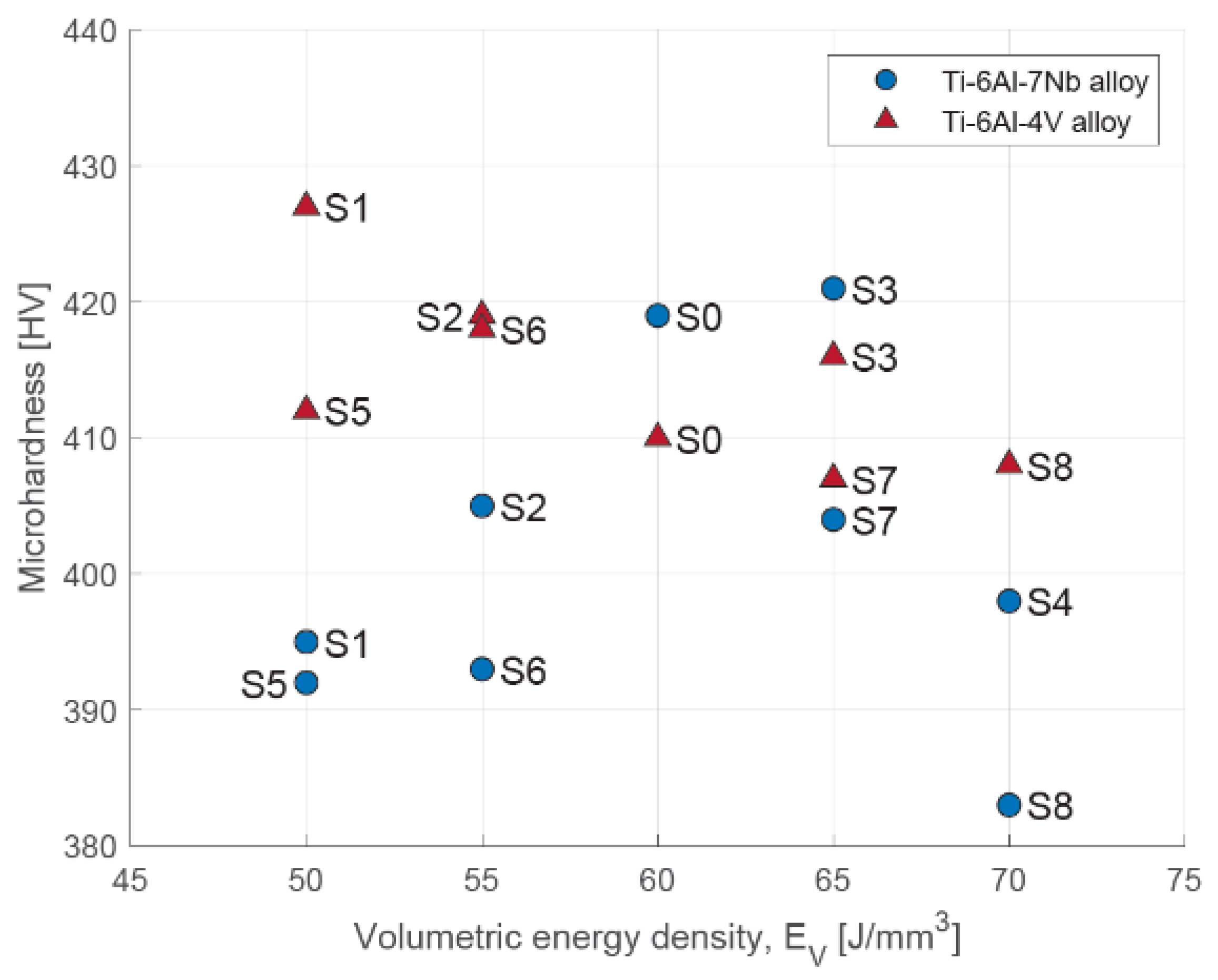
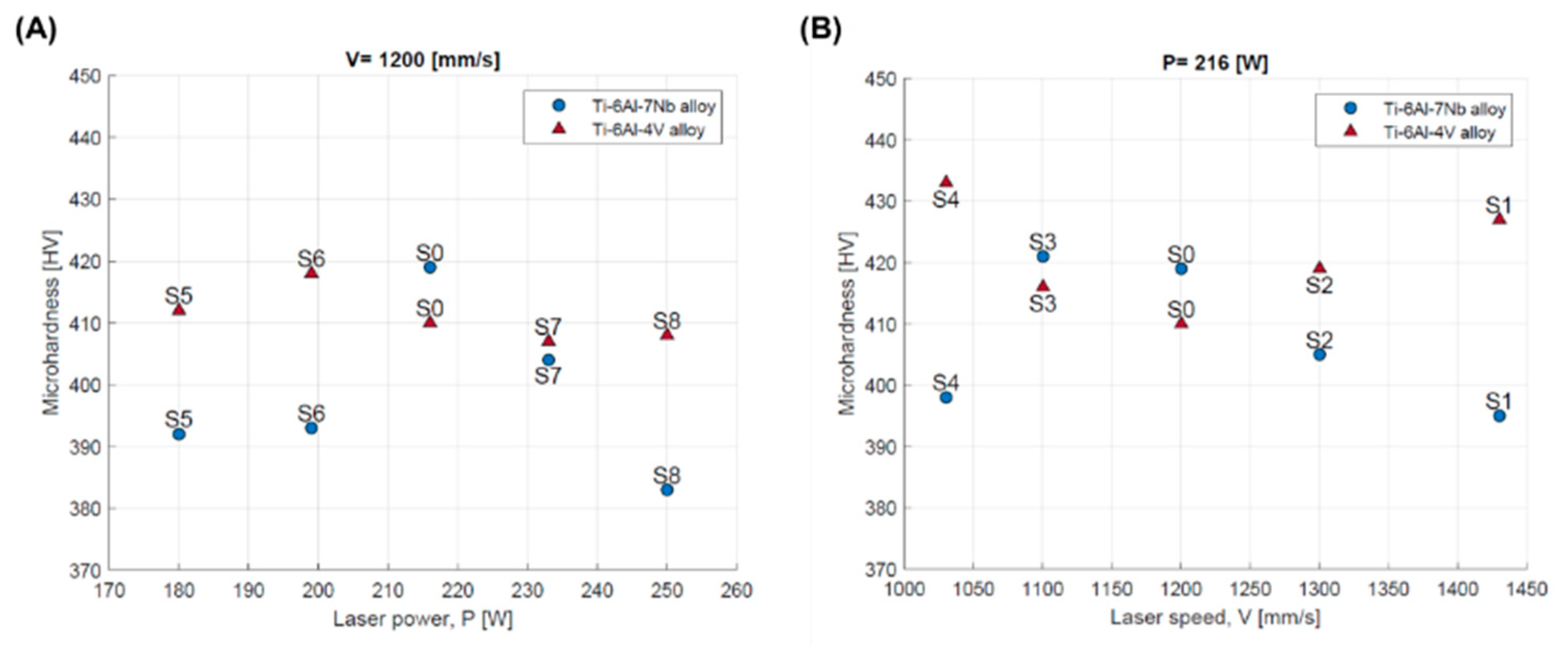
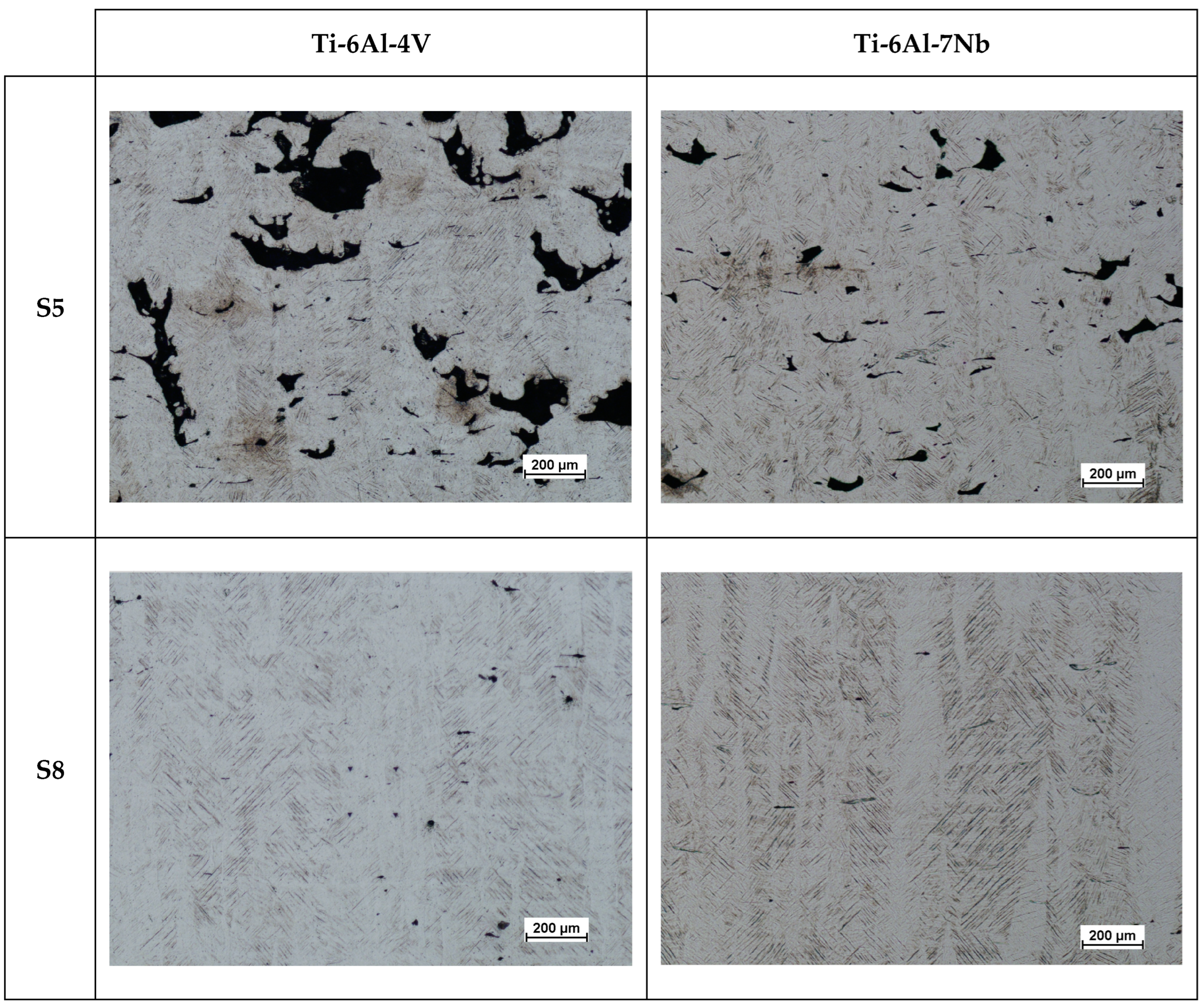

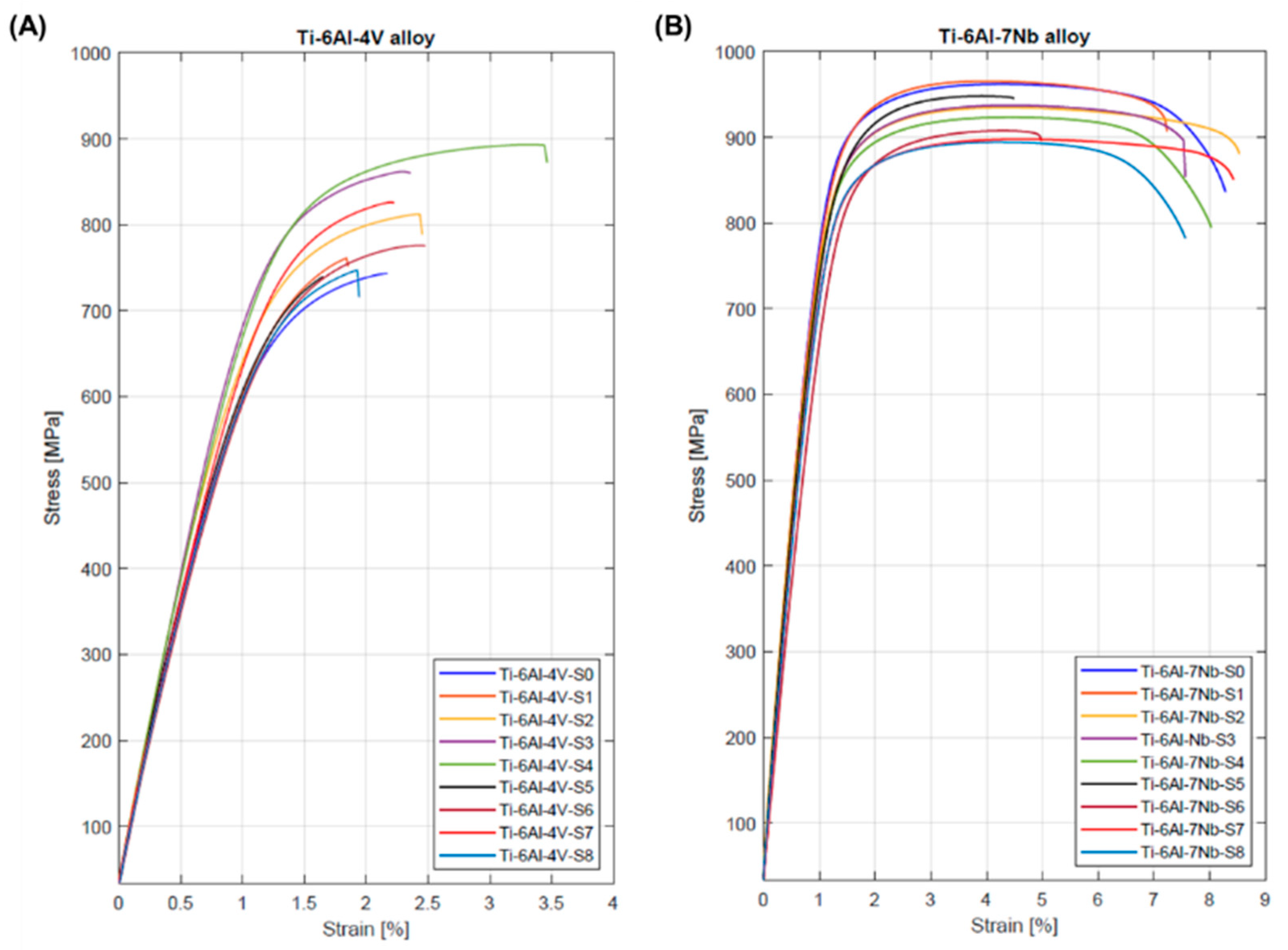
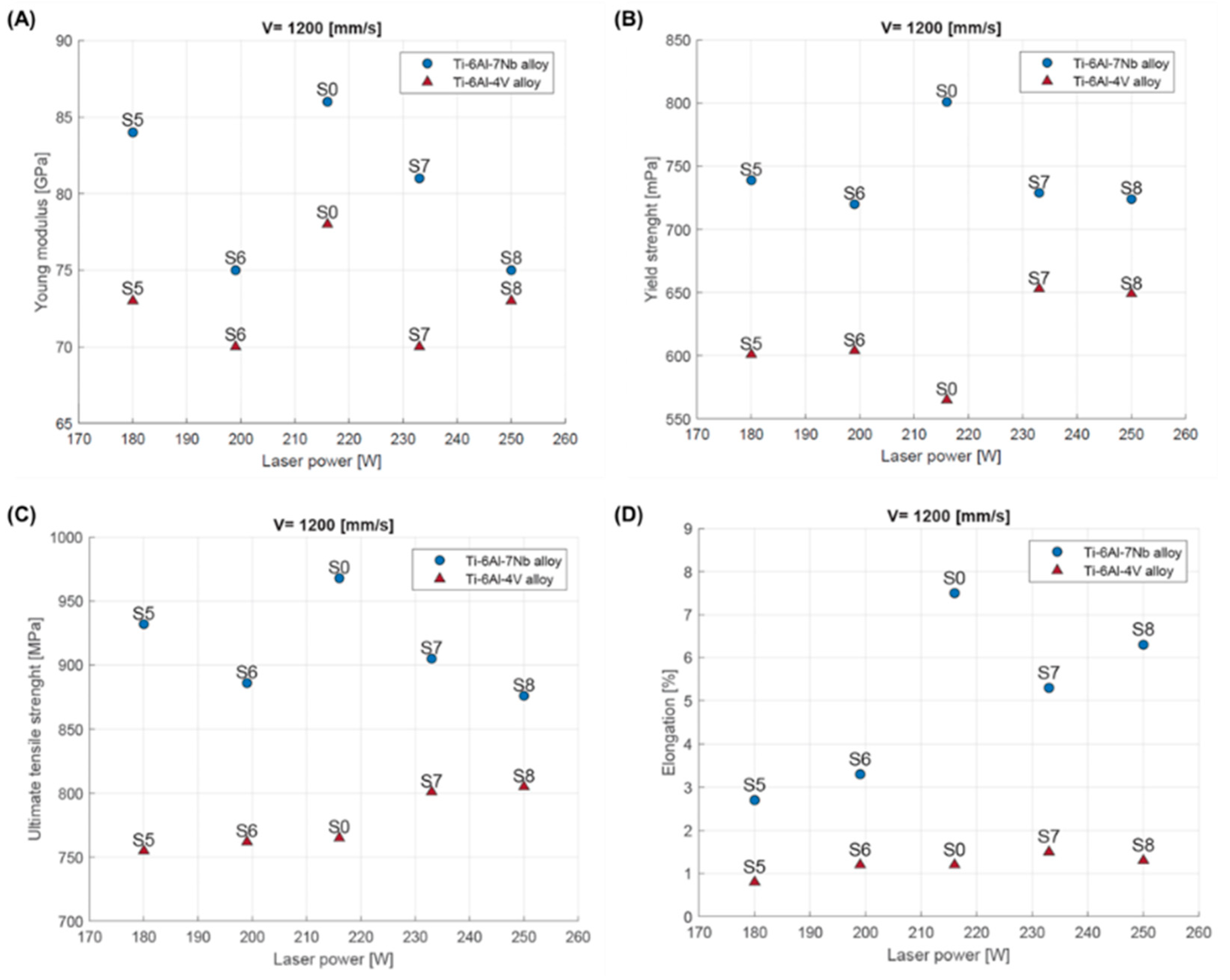
| Powder | Ti | Al | V | Nb | Fe | O | C | N | H |
|---|---|---|---|---|---|---|---|---|---|
| Ti-6Al-4V | Balance | 6.00 | 4.00 | - | ≤0.25 | ≤0.13 | ≤0.08 | ≤0.03 | ≤0.012 |
| Ti-6Al-7Nb | Balance | 6.05 | - | 7.1 | 0.15 | 0.08 | 0.015 | 0.016 | 0.001 |
| Manufacturing Strategy Symbol | Parameters | ||||
|---|---|---|---|---|---|
| P [W] | v [mm/s] | h [mm] | t [mm] | Ev [J/mm3] | |
| S0 | 216 | 1200 | 0.1 | 0.03 | 60 |
| S1 | 1430 | 50 | |||
| S2 | 1300 | 55 | |||
| S3 | 1100 | 65 | |||
| S4 | 1030 | 70 | |||
| S5 | 180 | 1200 | 50 | ||
| S6 | 199 | 55 | |||
| S7 | 233 | 65 | |||
| S8 | 250 | 70 | |||
| Manufacturing Strategy Symbol | Ti-6Al-4V | Ti-6Al-7Nb | ||
|---|---|---|---|---|
| ρAVR [g/cm3] | ρAVR [%] | ρAVR [g/cm3] | ρAVR [%] | |
| S0 | 4.254 ± 0.03 | 96.04 | 4.411 ± 0.03 | 97.80 |
| S1 | 4.166 ± 0.01 | 94.04 | 4.332 ± 0.03 | 96.06 |
| S2 | 4.282 ± 0.04 | 96.66 | 4.430 ± 0.02 | 98.23 |
| S3 | 4.336 ± 0.02 | 97.88 | 4.462 ± 0.02 | 98.95 |
| S4 | 4.322 ± 0.03 | 97.55 | 4.456 ± 0.02 | 98.79 |
| S5 | 4.161 ± 0.06 | 93.93 | 4.318 ± 0.05 | 95.75 |
| S6 | 4.225 ± 0.02 | 95.38 | 4.405 ± 0.02 | 97.67 |
| S7 | 4.213 ± 0.03 | 95.10 | 4.375 ± 0.02 | 97.00 |
| S8 | 4.360 ± 0.01 | 98.42 | 4.485 ± 0.01 | 99.44 |
| Manufacturing Strategy Symbol | Ti-6Al-4V | Ti-6Al-7Nb | ||
|---|---|---|---|---|
| Sa [μm] | Sz [μm] | Sa [μm] | Sz [μm] | |
| S0 | 14.3 ± 4.5 | 267 ± 50 | 16.6 ± 2.3 | 290 ± 25 |
| S1 | 24.0 ± 3.3 | 350 ± 13 | 22.3 ± 4.4 | 282 ± 28 |
| S2 | 13.0 ± 4.9 | 303 ± 61 | 13.0 ± 1.6 | 197 ± 22 |
| S3 | 10.9 ± 3.2 | 244 ± 36 | 11.4 ± 2.2 | 209 ± 7 |
| S4 | 12.7 ± 1.8 | 244 ±19 | 12.8 ± 2.2 | 238 ± 18 |
| S5 | 26.2 ± 5.2 | 311 ± 52 | 22.5 ± 5.4 | 306 ± 78 |
| S6 | 20.4 ± 5.2 | 315 ± 24 | 13.3 ± 1.5 | 253 ± 16 |
| S7 | 17.4 ± 2.0 | 256 ± 32 | 20.1 ± 4.1 | 356 ± 41 |
| S8 | 10.0 ± 3.6 | 184 ± 45 | 8.8 ± 2.0 | 187 ± 31 |
| Manufacturing Strategy Symbol | HV0.05 | ||||
|---|---|---|---|---|---|
| OB1 | OB2 | OB3 | OB4 | OB5 | |
| Ti-6Al-4V | |||||
| S0 | 438 ± 11 | 426 ± 7 | 449 ± 4 | 415 ± 10 | 410 ± 14 |
| S1 | 423 ± 8 | 414 ± 6 | 454 ± 17 | 418 ± 36 | 427 ± 8 |
| S2 | 446 ± 16 | 424 ± 10 | 420 ± 5 | 416 ± 30 | 419 ± 5 |
| S3 | 436 ± 4 | 419 ± 9 | 441 ± 13 | 436 ± 8 | 416 ± 4 |
| S4 | 427 ± 20 | 418 ± 13 | 429 ± 9 | 438 ± 4 | 433 ± 7 |
| S5 | 422 ± 10 | 420 ± 5 | 421 ± 9 | 411 ± 9 | 412 ± 13 |
| S6 | 421 ± 3 | 424 ± 11 | 413 ± 8 | 405 ± 12 | 418 ± 6 |
| S7 | 435 ± 6 | 414 ± 13 | 428 ± 13 | 426 ± 8 | 407 ± 26 |
| S8 | 420 ± 6 | 411 ± 12 | 413 ± 18 | 408 ± 25 | 408 ± 5 |
| Ti-6Al-7Nb | |||||
| S0 | 420 ± 7 | 423 ± 11 | 428 ± 8 | 448 ± 6 | 419 ± 5 |
| S1 | 402 ± 7 | 406 ± 10 | 430 ± 35 | 436 ± 4 | 395 ± 5 |
| S2 | 418 ± 7 | 433 ± 14 | 406 ± 12 | 430 ± 5 | 405 ±4 |
| S3 | 431 ± 7 | 420 ± 32 | 435 ± 9 | 433 ±8 | 421 ± 14 |
| S4 | 442 ± 5 | 436 ± 11 | 422 ± 10 | 435 ± 13 | 398 ± 3 |
| S5 | 424 ± 12 | 416 ± 10 | 428 ± 8 | 423 ± 8 | 392 ± 11 |
| S6 | 416 ± 9 | 410 ±5 | 349 ± 12 | 424 ± 8 | 393 ± 6 |
| S7 | 407 ± 10 | 435 ± 8 | 390 ± 10 | 432 ± 2 | 404 ± 6 |
| S8 | 394 ± 9 | 403 ± 12 | 386 ± 4 | 380 ± 11 | 383 ± 1 |
| Manufacturing Strategy Symbol | E [GPa] | Rp0.2 [MPa] | Rm [MPa] | A25mm [%] |
|---|---|---|---|---|
| Ti-6Al-4V | ||||
| S0 | 78 ± 12 | 565 ± 51 | 765 ± 22 | 1.2 ± 0.1 |
| S1 | 67 ± 4 | 591 ± 22 | 724 ± 33 | 0.9 ± 0.2 |
| S2 | 76 ± 4 | 588 ± 26 | 784 ± 25 | 1.4 ± 0.3 |
| S3 | 80 ± 9 | 686 ± 54 | 860 ± 31 | 1.6 ± 0.5 |
| S4 | 79 ± 5 | 726 ± 64 | 912 ± 17 | 2.2 ± 0.2 |
| S5 | 73 ± 2 | 601 ± 20 | 755 ± 25 | 0.8 ± 0.1 |
| S6 | 70 ± 4 | 604 ± 15 | 762 ± 11 | 1.2 ± 0.2 |
| S7 | 70 ± 4 | 653 ± 19 | 801 ± 28 | 1.5 ± 0.3 |
| S8 | 73 ± 4 | 649 ± 40 | 805 ± 38 | 1.3 ± 0.2 |
| Ti-6Al-7Nb | ||||
| S0 | 86 ± 5 | 801 ± 13 | 968 ± 8 | 7.5 ± 1.0 |
| S1 | 88 ± 3 | 789 ± 13 | 977 ± 17 | 5.4 ± 0.6 |
| S2 | 84 ± 3 | 779 ± 18 | 945 ± 20 | 5.7 ± 2.4 |
| S3 | 83 ± 3 | 769 ± 13 | 925 ± 16 | 7.6 ± 0.9 |
| S4 | 82 ± 4 | 778 ± 13 | 932 ± 9 | 7.5 ± 0.6 |
| S5 | 84 ± 2 | 739 ± 7 | 932 ± 8 | 2.7 ± 1.1 |
| S6 | 75 ± 5 | 720 ± 25 | 886 ± 24 | 3.3 ± 0.9 |
| S7 | 81 ± 4 | 729 ± 25 | 905 ± 15 | 5.3 ± 1.5 |
| S8 | 75 ± 3 | 724 ± 28 | 876 ± 17 | 6.3 ±1.5 |
Disclaimer/Publisher’s Note: The statements, opinions and data contained in all publications are solely those of the individual author(s) and contributor(s) and not of MDPI and/or the editor(s). MDPI and/or the editor(s) disclaim responsibility for any injury to people or property resulting from any ideas, methods, instructions or products referred to in the content. |
© 2024 by the authors. Licensee MDPI, Basel, Switzerland. This article is an open access article distributed under the terms and conditions of the Creative Commons Attribution (CC BY) license (https://creativecommons.org/licenses/by/4.0/).
Share and Cite
Laskowska, D.; Bałasz, B.; Zawadka, W. Microstructure and Mechanical Properties of As-Built Ti-6Al-4V and Ti-6Al-7Nb Alloys Produced by Selective Laser Melting Technology. Materials 2024, 17, 4604. https://doi.org/10.3390/ma17184604
Laskowska D, Bałasz B, Zawadka W. Microstructure and Mechanical Properties of As-Built Ti-6Al-4V and Ti-6Al-7Nb Alloys Produced by Selective Laser Melting Technology. Materials. 2024; 17(18):4604. https://doi.org/10.3390/ma17184604
Chicago/Turabian StyleLaskowska, Dorota, Błażej Bałasz, and Wojciech Zawadka. 2024. "Microstructure and Mechanical Properties of As-Built Ti-6Al-4V and Ti-6Al-7Nb Alloys Produced by Selective Laser Melting Technology" Materials 17, no. 18: 4604. https://doi.org/10.3390/ma17184604
APA StyleLaskowska, D., Bałasz, B., & Zawadka, W. (2024). Microstructure and Mechanical Properties of As-Built Ti-6Al-4V and Ti-6Al-7Nb Alloys Produced by Selective Laser Melting Technology. Materials, 17(18), 4604. https://doi.org/10.3390/ma17184604








